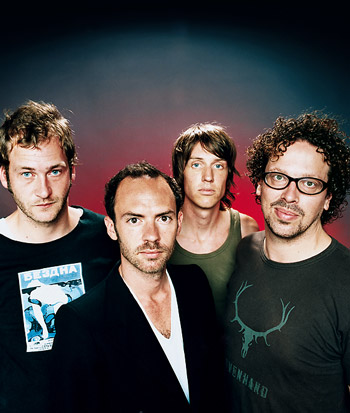
YouTube may be the peepshow of the inane, but being famous for 15 megabytes can work wonders for your music career. Just ask Alamo Race Track, the Amsterdam quartet whose performance of the song “Black Cat John Brown” has topped a half-million views on the video site. While you might expect such a popular clip to include irony-laced gags, celebrity spoofs or trippy animation, singer/guitarist Ralph Mulder explains otherwise.
“It’s just four guys sweating in a small dressing room,” he says.
Actually, it’s an oasis of reality in a virtual world, depicting the members of Alamo Race Track banging out “Black Cat John Brown”—a Beatlesque blues shuffle built on a simple acoustic-guitar lick—before a small group of fans backstage. As a result, Mulder and his bandmates—bassist/singer David Corel, guitarist Leonard Lucieer and drummer Guy Bours—are enjoying the kind of international acclaim that few Dutch groups ever achieve. Aside from Solex and Bettie Serveert (whose producer, Frans Hagenaars, also oversaw Black Cat John Brown, Alamo’s recent album on Minty Fresh), Dutch music has barely been a blip on the radar to those outside its small scene.
“Bettie Serveert and Solex are all friends of ours,” says Mulder. “We’ve got certain hang-out places in Amsterdam where friends have bars or coffee shops. It’s like a family thing going on.”
The four members of Alamo Race Track have been playing together for a decade, dating back to their membership in college band Redivider, which was initially an acoustic act due to lack of funds. Mulder sheepishly admits that Redivider won a battle of the bands-type competition in order to purchase amplifiers and electric guitars. In 2001, the group morphed into Alamo Race Track, a name chosen by Mulder for its Dixie connotations.
“I know it’s really weird for a Northern European boy to [identify with] the American South, but I always wanted to visit there,” says Mulder, who spends his spare time playing banjo and reading books by Southern authors. “My father and mother are really into the Delta blues. I’ve always had this wish but never had the money to go there, so I got a map of the Southern United States and would pinpoint where I wanted to go. I came across a lot of villages called Alamo, and I noticed there were a lot of racetracks everywhere as well. I was picturing these beautiful, white-painted, 19th-century horse racetracks.”
A much larger map is needed to navigate the sound of Black Cat John Brown, an album with few audible Southern accents and a surplus of sharply executed modern-rock motifs. Mulder moves from a chilly baritone on the Interpol-esque “The Killing” to a Kinks-y piano bounce on “Stanley Vs. Hannah” (featuring a female co-vocalist), and the songs are just as likely to meditate on a fruity marimba melody as stab you with Strokes-like guitar. Forced to choose among the album’s many mood swings, Mulder predictably favors the black cat that’s brought his band good luck.
“I’d have to pick ‘Black Cat John Brown,’” he says. “I wrote it in the wintertime in my apartment, and there was a black cat sitting on my window (ledge) during the whole time I was working on the song. He’s still there sometimes, wandering around. I don’t know if he knows I wrote a song for him.”
—Matthew Fritch





